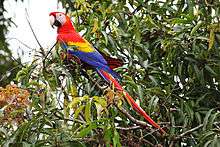Carara National Park
| Carara National Park | |
|---|---|
|
IUCN category II (national park) | |
|
Entrance | |
 | |
| Location | Costa Rica |
| Coordinates | 9°44′50″N 84°37′40″W / 9.74722°N 84.62778°WCoordinates: 9°44′50″N 84°37′40″W / 9.74722°N 84.62778°W |
| Area | 52 km2 |
| Established | 1978 |
| Governing body | National System of Conservation Areas (SINAC) |
Carara National Park is a national park in the Central Pacific Conservation Area located near the Pacific coast of Costa Rica. It was established on April 27, 1978 as a biological reserve, but its growing popularity after 1990 forced the government to upgrade its category to national park in November 1998.[1]
Carara lies about 30 miles west of the Costa Rican capital of San José and about 15 miles north of the beach town of Jacó. The park protects the river basin of the River Tárcoles, near Orotina and includes one of the largest remaining populations of wild scarlet macaws in the country.
Biodiversity
Carara National Park contains more primary rainforest than the relatively close Manuel Antonio National Park. As such, it is wetter than the more popular Manuel Antonio National Park, and has denser tree growth and more mosquitoes and other insects. This environment makes Carara a haven for many bird species making the park a popular birdwatching destination. In addition to scarlet macaws, birds found in Carara include orange-chinned parakeets and other parrots, hummingbirds, woodpeckers, motmots, jacamars, manakins, antbirds, and several species of trogon, including the black-throated trogon. Several species of water birds inhabit the park as well. These include the anhinga, several species of heron, egret and kingfishers.
Among the reptiles present in the park are the American crocodile and several snake and lizard species. The Tarcoles River, which forms the northern boundary of the park, is inhabited by crocodiles throughout most of the year.[2] Green and black poison arrow frogs are among the amphibians present. Mammals include white-tailed deer, red brockets, collared peccaries, agouti, kinkajous, white-faced capuchin monkeys, mantled howler monkeys, Hoffmann's two-toed sloths and brown-throated three-toed sloths. However, mammals can be difficult to see due to the dense tree cover.
Resources
The Carara National Park universal footpath has a wide range of audio-visual and haptic resources using advanced technology to facilitate easy access for people with disabilities. Designed by architect Ibo Bonilla and built by popular contribution, the park has facilitative features such as animal sculptures, haptic maps, Braille signs, etc.
The tour around the park has slopes less than 6%, areas with benches for rest, park information booths, and special health services.
Archeological sites
Carara National Park has fifteen pre-Columbian archaeological sites belonging to the archaeological area of the Central Region of Costa Rica, corresponding to two periods of occupation: the "Pavas" period (300 BC to 300 AD) and the "Cartago" period (800-1500 AD).
Two sites stand out in the park. The first is characterized by the presence of a rectangular base measuring 6 x 4 meters, corresponding to the "Cartago" period. It is built of limestone and river rocks. Another important site is Hills Burial, which is a large residential village and burial area located on a hill facing the "Tárcoles River". It is believed that this village exerted political and economic dominance on the lower part of this river.
Gallery
| Flora, Fauna, and Activities in the Park | ||||||||||||||||||||
|---|---|---|---|---|---|---|---|---|---|---|---|---|---|---|---|---|---|---|---|---|
|
Footnotes
- ↑ "Carara National Park at SINAC official site (In Spanish)". Archived from the original on 2010-12-15. Retrieved 2008-02-25.
- ↑ "Biodiversity in Carara National Park".
External links
 Media related to Carara National Park at Wikimedia Commons
Media related to Carara National Park at Wikimedia Commons- Carara National Park at Costa Rica National Parks website




